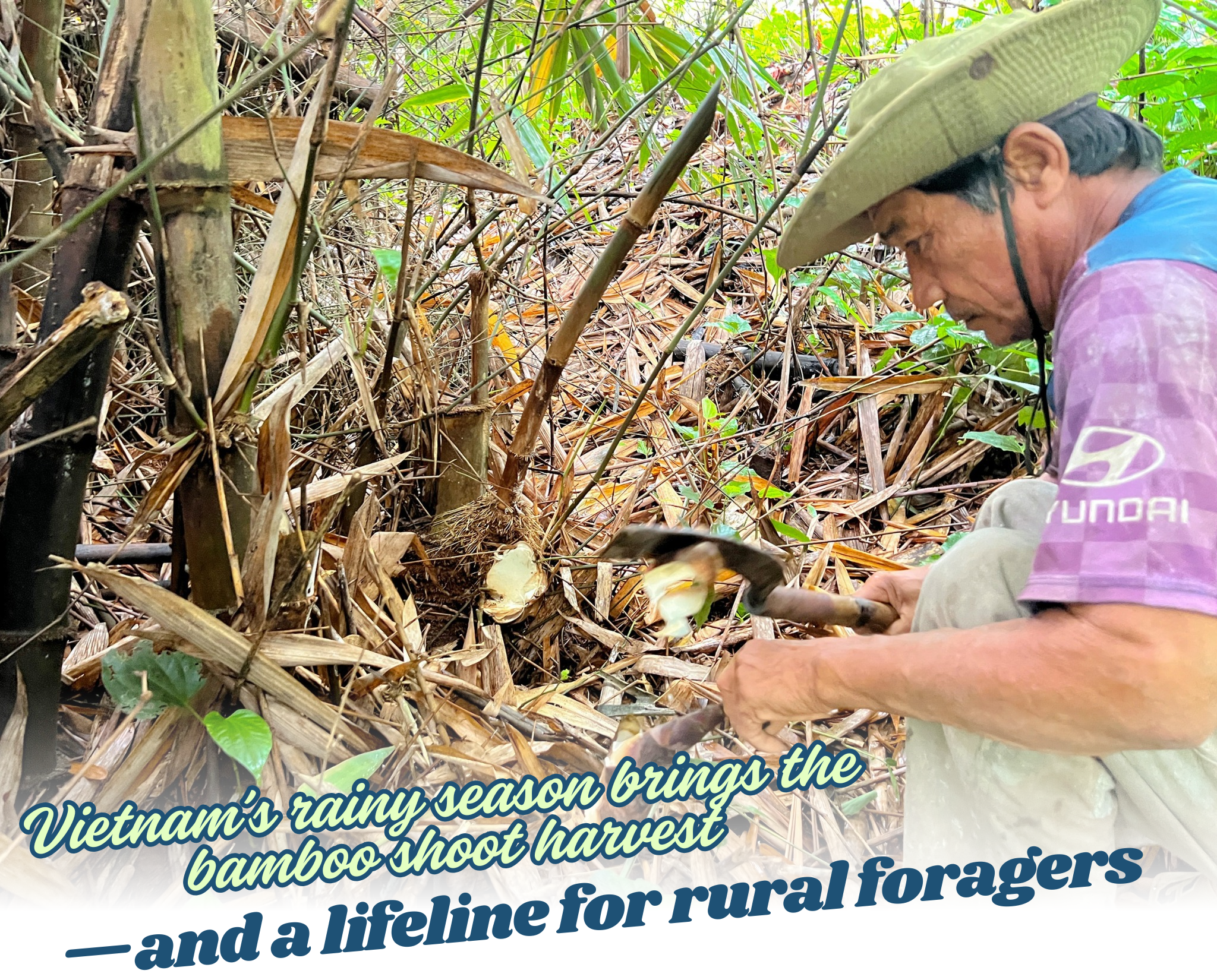Please enter Email
Email Invalid Format
Please enter your Full Name.

As the first steady rains fall across Vietnam’s southern highlands, it signals more than the start of the wet season—it’s also the beginning of the annual bamboo shoot harvest, a critical source of income for many rural families.
Armed with machetes, large cooking pots, and bundles of firewood, residents of Nghia Trung Commune in Dong Nai Province—previously part of old Binh Phuoc province—are gearing up for what they hope will be a fruitful season.
This year’s persistent but gentle rains have locals optimistic: they believe it’s the perfect condition for a bumper crop of plump bamboo shoots.
At dawn, under a light drizzle, 30-year-old Dieu Sieng hurriedly finishes a cold bowl of rice and heads out with a 10-kilogram basket and a trusty machete.
He’s meeting up with two fellow foragers—Nguyen Van Thang, 29, and Nguyen Van Don, 49—at a cashew farm nearly 20 kilometers from his home.
The trio locks their motorbikes together with a chain and treks another kilometer on foot, deep into the forest.
“We don’t know if there’ll be much yet—some shoots are just breaking through the soil,” said Sieng.
“But if we don’t go now, others will get there first.”
Nguyen Van Don clears underbrush while searching for bamboo shoots in a forested area in Dong Nai Province, southern Vietnam, July 2025. The task carries risks such as scratches and insect stings. Photo: An Vi
The team is searching for lo o (Bambusa balcooa) bamboo shoots, which grow wild in thickets along stream beds near cashew and rubber plantations that sprawl across the former Binh Phuoc Province.
As they descend a steep slope, thick clusters of lo o bamboo come into view.
Sieng, who learned to forage as a child from his S’tieng parents, slashes a path forward.
But the pickings are slim—most of the shoots are still too small.
“Give it another two weeks and they’ll be ready,” he said, noting that on his own land, he’d have prepped the bamboo clumps with fire before the rains—an old trick to encourage growth.
Undeterred, the group hikes another five kilometers through rubber plantations.
Sieng is determined to find at least a few young shoots to bring home for soup.
Nguyen Van Don, the most experienced forager in the group, clears the underbrush ahead.
Nguyen Van Don inspects young bamboo shoots he plans to cook into soup, during a foraging trip in Dong Nai Province, southern Vietnam, July 2025. Photo: An Vi
Originally from the Mekong Delta, he moved to old Binh Phuoc to harvest cashew nuts for hire, and now collects wild herbs, rattan shoots, and mushrooms during the rainy season.
But even he comes up short today.
The team ends up with just four tender shoots, which they later pool together to cook with a pig’s tail for dinner.
“It’s a long trek for a small haul,” Don joked, wiping rain from his brow.
With the cashew harvest ending early this year, seasonal laborers like Sieng and Don now rely on the wild bounty of the rainy season to make ends meet.
“It’s the lean season,” Don said.
“If we get a lot of bamboo and termite mushrooms, we’ll manage.
“If not, it’s just rice with salt.”
Lam Van Tien inspects young bamboo shoots he plans to cook into soup, during a foraging trip in Dong Nai Province, southern Vietnam, July 2025. Photo: Ngoc Sang
A few years ago, Sieng could earn over VND1 million ($38) a day harvesting bamboo shoots.
But with rising competition and fewer natural stands, he now makes just VND400,000 ($15) to VND500,000 ($19) on a good day.
“This year the price is better—about VND5,000 [$0.2] more per kilo,” he noted.
“If we peel the shoots and sell them fresh, we get VND20,000 [$0.8] per kilo.
“Drying them brings more, but that takes time and effort—and the weather doesn’t always cooperate.”
Elsewhere, other groups report better luck.
Other foragers have started collecting enough bamboo shoots to justify the effort of crossing streams, hiking forest trails, and battling leeches and mosquitoes.
Back in Phuoc Son Commune, 45-year-old Lam Van Tien returns home with a sack of freshly-cut shoots slung over his shoulder.
His shirt is soaked in sweat, his pants caked in mud.
He doesn’t stop to rest.
A woman slices boiled bamboo shoots for drying in Dong Nai Province, southern Vietnam, July 2025. Photo: Ngoc Sang
Tien fills a large pot with water, lights a wood fire, and begins boiling the shoots, releasing a distinct, earthy aroma into the air.
“Fresh shoots need to be boiled right away,” he said.
“Otherwise, they turn sour and discolored—nobody wants to buy them.”
Freshly-harvested bamboo shoots are seen during the early rainy season in Dong Nai Province, southern Vietnam, July 2025. Photo: An Vi
The early-season price for fresh bamboo shoots hovers between VN15,000 to VND20,000 (US$0.6–0.8) per kilogram in rural markets.
Tien peels and slices the shoots along the grain—a delicate step that ensures they dry evenly in the sun.
On sunny days, he spreads them in neat rows across bamboo trays, setting them out in the yard.
But when the rains return, he turns to wood-fired drying, carefully tending the fire and checking regularly to prevent spoilage.
“Dried shoots fetch a higher price,” Tien said.
“They keep longer and look better when they dry evenly.”
The finished product carries the scent of the red earth, sun, and smoke—an imprint of the mountains and the toil of men like Tien, a member of Vietnam’s Tay ethnic minority who has built his life around the forest.
Please enter Display Name
Please enter Email
Email Invalid Format
Please enter Email
Email Invalid Format
Incorrect password.
Incorrect login information.
Account locked, please contact administrator.
An error occurred. Please try again later.
Max: 1500 characters
There are no comments yet. Be the first to comment.